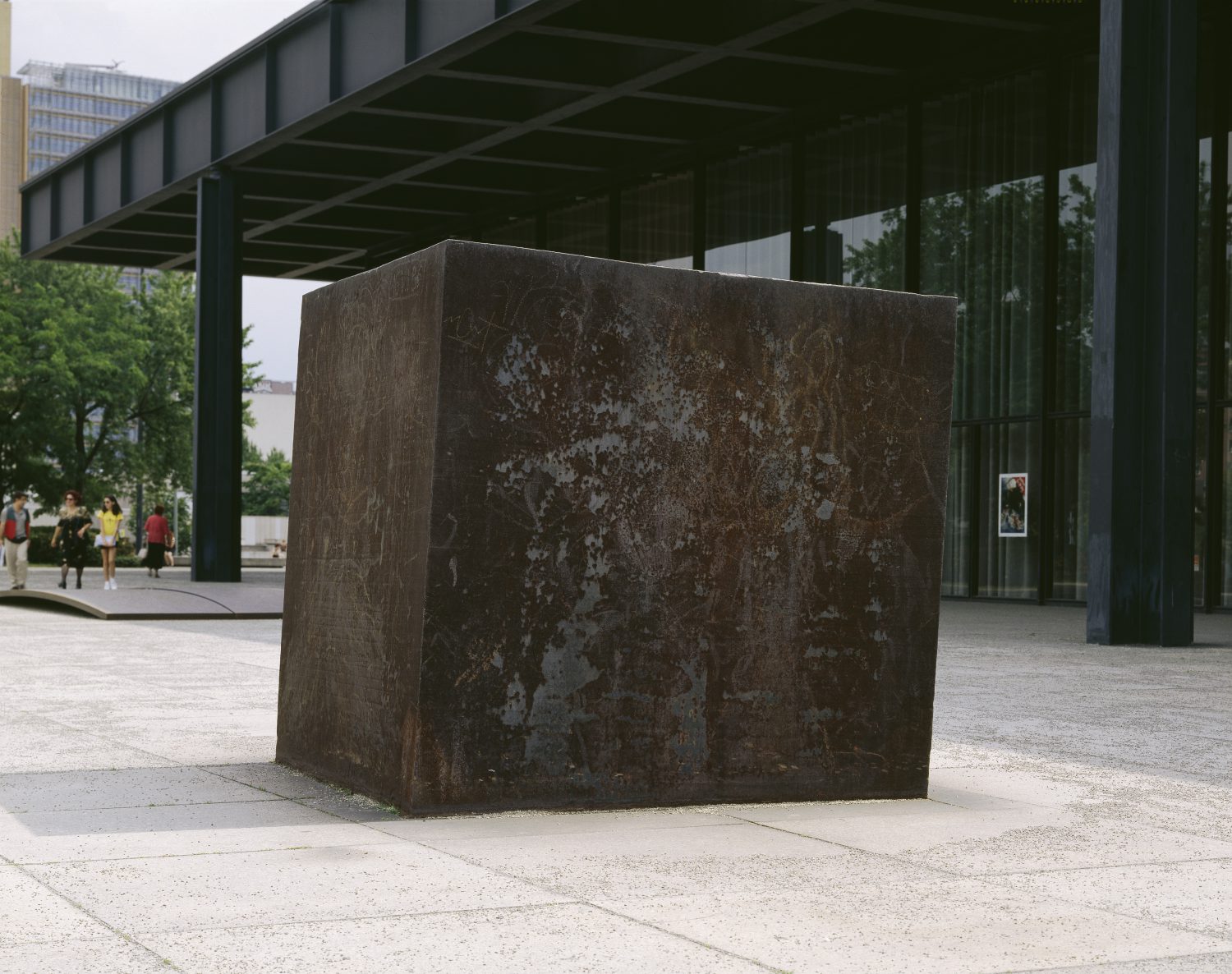Richard Serra
Berlin Block for Charlie Chaplin, 1978
Artist
Richard Serra
Title
Berlin Block for Charlie Chaplin
Year of creation
1978
Technology and dimensions
Iron, forged, 200 x 200 x 200 cm, weight approx. 7 t
Year of acquisition
1979
Since the 70-ton block made of forged iron was erected on the terrace of the Neue Nationalgalerie on September 29, 1979, the Berlin Block for Charlie Chaplin has been one of the landmarks of the Mies van der Rohe area. Richard Serra consciously designed the work for this location and carefully explored the relationship of his massive block, which is slightly tilted into the terrace floor, to the widely scanned, transparent architecture of the gallery.
Looking back, Serra explained his thoughts at the time in an interview in 1979: “Meanwhile, I received an order from the Nationalgalerie Berlin to propose a project. Mies van der Rohe's platform is a rectangular construction, just like the building. a square on a square. It therefore seemed impossible to me to build another structure on top of this structure. I didn't want to add another artifact, but something that inherently held its volume, its weight and made gravity tangible. I therefore decided to sink a massive cube 7.5 cm deep into the concrete slabs on one side.”
Serra discovered the steelworks suitable for his project in Hattingen. The block was made and forged in the Henrichshütte there from December 1977 to January 1978 in the presence of the artist. “I had seen an 80-foot-tall blacksmith's hammer near Thyssen in the Ruhr Valley and I wanted to work with it. The forge is essentially a hydraulic hammer that presses metal under pressure. The difference from casting is that a cast volume weighs a third to half less than a forged volume of the same dimension. I found that the hotter the material, the less pressure the hammers require. I used a specific steel that had to be heated to white heat at 1,280°C in order to be able to control the manipulation of the hammers.”
Before the sculpture was installed at the end of September, a fifteen-meter-high support structure had to be installed within the Mies building because the load-bearing capacity of the platform was beyond capacity, “Therefore, a column with round iron reinforcement had to be built under the sculpture, i.e. a pillar in the museum. I see it as an extension of montage, renewing the architecture so that it supports the sculpture. (…) I believe that if sculpture has any potential at all, it is to create its own place and space in order to contradict the spaces and places for which it was made.”
But the contradiction mentioned has First of all, a commonality as a prerequisite. Both works, the house and the compact cube, which, to a certain extent, moves into the extended protective space of the extended roof, are built on the square, an elementary form that, like no other, is considered a symbol of balance and a consolidated calm. The contrasts develop from this relationship, of which the slight inclination is the most important moment. This “trick” not only destabilizes the inherent weight of the block, but the resulting dynamic dimension unexpectedly also affects the calm aura of the hall building. At the same time, the “affection” of the massively compacted cube connects it with the weight of the cantilevered ceiling construction.
On the other hand, despite its comparatively small size, the block, due to its extremely solid unity, becomes a potential counterpart to the open steel-glass structure, in which a designated center, a kind of core substance, was deliberately avoided in favor of consistent lightness. The force of the iron cube seems to want to push into this “vacuum”. One could also say that the altar missing from the temple, although placed outside, was added later. An inner connection has emerged between the two independent works of art, which extends beyond the tectonic proximity to the broader inner expressiveness. This also corresponds to what Dieter Honisch wrote about the Berlin Block for Charlie Chaplin in 1980: “The expenditure on materials is counteracted by the devaluation of this material - through the slanting -; the overemphasis on the physical becomes at the same time a question about the metaphysical: tomb, sacrificial site, Kaaba , memorial? The iconographic allusion is immediately clear and also suggested in the 'artlessness' of the object.”
Fritz Jacobi
